Postwar Underwater Minerals Ave. 632 and Ave 648
Priority in the creation of underwater mine-laying belongs to Russia. The first ship of this destination was designed by MP Naletov and built in 1912, the submarine "Crab", which could take on board up to 60 anchor mines and 4 torpedoes. In the future, the experience of two world wars confirmed the high efficiency of submarines of this class in combat operations at sea. The most successful of the pre-war Soviet submarine projects (submarines) capable of carrying mine weaponturned out to be a submarine type "L". However, a small number of them, as well as a relatively small ammunition mines (on submarines XIII and XIII bis 18 series, units, on boats II and XI series on 20) led to the fact that during the war, work began on expanding the use of sea mines submarines of available projects.
I must say that there were two directions in this case. The first involved the use of existing models of boat mines, which were set up using special mine tubes or from mine-ballast tanks. The second required the creation of new types of mines that can be set using standard boat torpedo tubes (TA). And if, having a priority in this area, our country developed the first direction, then Germany, having begun their construction with regard to the "Russian" type, later focused on the creation of boat mines made of torpedo tubes, in which it outpaced all other fleets.
In our country, respectively, during the Patriotic War, mine-ballast tanks were installed on the medium submarine Shch-101 and the small M-171 in addition to torpedo armament. The first model of a boat mine (PLT-3), adapted for setting from a 53-cm torpedo tube, was also adopted in wartime, in 1943. And although a year later the fleet received another and more effective AMD-1000 mine, which, by the way, could be displayed not only from boats, surface ships and boats, but also from aviation carriers, until the end of the war, none of our submarines was upgraded to use them. At the same time, the General Naval Staff, in its proposals for the prospective construction of the Navy for the post-war period, noted the expediency of having fleet an underwater mine layer with a displacement of about 1200 tons with 126 mines, a range of up to 25000 miles and an autonomy of 60 days. But they returned to this idea only a decade later, when we had large submarines, pr. 611.
20 September 1956, the Commander-in-Chief of the Navy approved a tactical and technical task for the creation of a large underwater mine layer, capable of taking on board the 80-100 new submarines of the type PLT-6 and putting them underwater 3-10 min in each. In addition, TTZ required to provide for the possibility of converting such a boat by naval bases to perform special transport tasks, and also stipulated its ability to carry 10 tons of aviation fuel (gasoline or kerosene) in any use case when receiving it into an overload into fuel-ballast tanks.
The work on the creation of such a boat, which received the cipher — 632 ave., Was assigned to TsKB-18. The chief designer of the project was appointed Ya.E. Yevgrafov, formerly the chief designer of submarines of the 613 and 640 projects. First, in accordance with the TTZ, they began preliminary studies of the two main methods of maintaining mines on the ship: “dry” - with their storage on racks inside a solid hull and “wet”, with unattended storage of mines, in water-filled mine tubes. According to their results, they planned to choose the final version and develop a draft design on its basis. However, there were no clear advantages of this or that option, and therefore they decided to develop in full draft designs for both methods. But since TsKB-18 was under tremendous pressure, working on the project of a new large torpedo submarine, 641 Ave., replacing 611 Ave. Subs. Pr. B-16 and AB-611. All the documentation developed by the minelayer and more than 611% prepared was transferred there from TsKB-18, and YA.E. Evgrafova and Yu.E. Kitsina.
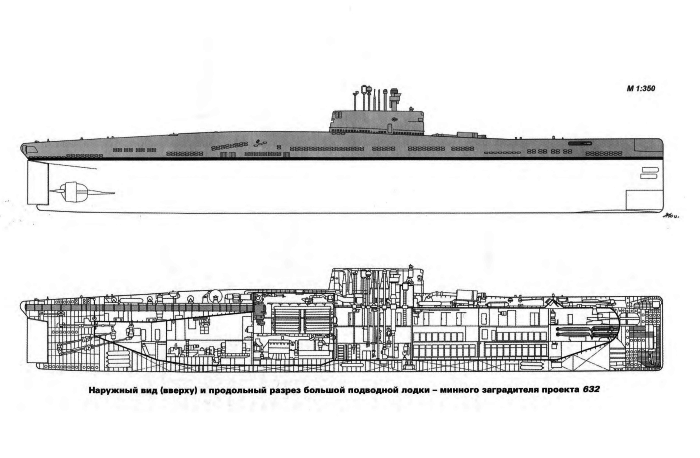
In further work, the first option, which, incidentally, was the basis for the technical design, provided for “dry” storage of mines in four mine tubes (8 pieces each) and reloading them with spare mines (56 pieces) placed on racks in the durable compartment enclosures. Thus, boat ammunition reached 88 min. The second option was calculated for the “wet” storage of 80 mines in six mine tubes (15 pieces each) without the possibility of their maintenance at sea.
In both cases, the solid submarine hull was divided into 7 compartments, and the most significant structural differences, depending on the variant, had fifth compartments. Thus, in the first version, the “eight-dimensional” form of its robust building was provided, in the upper part of which breech parts and mine tube drives, a mine-control post, and also racks with spare mines were located. In the lower part, separated from the upper gas-dense expansion platform, the equipment and mechanisms of the power plant of the ship were located. In the second variant, the compartment case was made in the traditional form of a cylinder.
The design and layout of the mine tubes in both versions had fundamental differences. So, in the first variant there were two of them on board, they, going beyond the robust hull, went from the end bulkhead of the 5 compartment to the aft end of the submarine with the dissolution angle about 20 °, and located closer to the diametral plane, had a decrease in aft around 1 °, providing all the mine tubes to the transom of the stern end of the ship at the same height relative to its main plane. In the second variant, mine tubes (three on board) stretched from the end bulkhead of the 1 compartment, also to the stern end of the ship.
It should be noted that several so-called non-core options were also studied in parallel. In particular, a combined (“dry” + “wet”) method of storing mines was worked out. With their total number in 110, 28 mines were taken to 2 "dry" mine tubes, 28 mines to racks in the bottom of the 2 compartment, 52 mines to four wet mines and another 2 mines to external Fences serving for loading mines into mine tubes. Under this option, the minelayer met the requirements of the TTZ in terms of the maximum speed of the underwater course (up to 17 knots) and exceeded the task of mines stock. He envisaged the division of a durable submarine hull into six compartments. At the same time, the 5 became the mine compartment instead of the 2. In total, except for the two main ones, albeit with a lesser degree of detail, four additional variants of the ship design were developed, in which both “dry” and “wet” methods of storing mines were used.
However, based on the results of a review of the outline design, the chief designer and bureau management recommended that the ship continue to be further designed only on the basis of the first option. Here it was possible to place mines in the entire depth range of the boat — from the periscope to the 250 m. The rear covers of each pipe were in the mine compartment and equipped with creamer paddles, the front - outer - had special brackets with rollers that served as a continuation of the guides in the pipe, which ensured unhindered gathering min. Opening and closing of the covers was provided with the help of hydraulic actuators, but there were also reserve manual actuators. The mines in the pipes were in a state fully prepared for production, and therefore they did not need to be inspected and maintained at sea. The mines stored without fuses on the racks were available for inspection and maintenance.
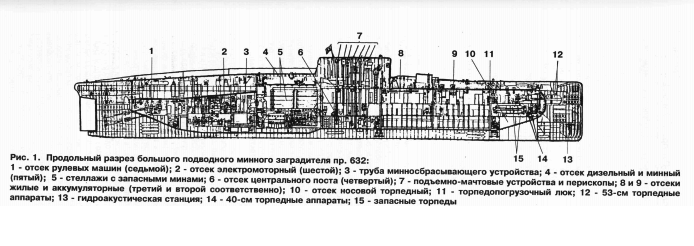
The setting of the mines after performing preparatory operations (filling the annular gap, equalizing the pressure, opening the front cover and removing the stoppers for securing the mines "traveling") should have been done automatically. The reloading of the mine tubes could be carried out on the move in any position of the submarine with trimments up to 5 °, and the design of the mine-dropping device precluded the possibility of spontaneous displacement of the mines during reloading and operation.
In accordance with the TTZ in the conceptual design was carried out and study the possibility of transporting troops. She showed that without increasing the size and displacement of the ship, in the absence of mines in the mine compartment, 100 people could be placed. At the same time, a number of compartment equipment elements had to be removable in order to replace mine storage racks, equip beds and a bathroom, install additional fans and air purification filters, galley equipment, provide a device for discarding waste, etc. However, the ability to perform such work by the forces of the naval base workshops, even in the presence of interchangeable equipment, looked problematic.
In September 1957, the conceptual design was submitted for review, and in February 1958, it was approved by a joint decision of the MOP and the Navy. Moreover, along with a positive assessment of the project, a number of comments and suggestions were made that should be taken into account in the technical project. Work progressed rapidly, and in August of the same year, the technical project was submitted for approval. In it, tactical, technical and shipbuilding elements of a large underwater mine layer of the 632 pr. Compared with the draft design have changed little: only the normal displacement from 3000 t increased to 3200 t - the greatest length - from 81,7 m to 85,0 m, draft - from 6,8 m to 6,95. In addition, as a result of the specification of electric power consumption and propulsion qualities of propulsion, as well as hull characteristics, from 700 to 800 miles, the estimated cruising range of the submerged economic course increased.
It should be noted that in October 1958, the bureau, in consultation with the Navy, began to develop an abbreviated pre-draft project of the same minzag, but which involved the use of a small-sized nuclear power plant of the type "0-153". This project has been assigned the 632M cipher. However, when the Decree of the Central Committee of the CPSU and the USSR Council of Ministers of the USSR, which determined the shipbuilding program for seven years, was issued in December of 1958, the 632 Ave. boat was not there, and its technical design was not approved. The decision did not say anything about the project 632M.
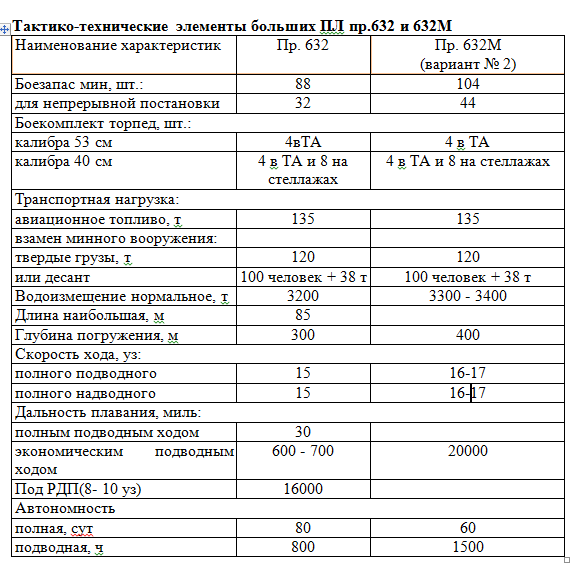
Almost in parallel with the above-mentioned works, in the same TsKB-16, a project of a large transport submarine was created, the main purpose of which was to supply enemy submarines operating on the enemy’s ocean and sea communications, torpedo and rocket ammunition, diesel fuel, food and means of regeneration. Those. the boat was assigned tasks similar to those of the German transport submarines of the Second World War, known as “milk cows”. But besides this, TTZ from 1957 of the year made a requirement to provide for the possibility of transporting aviation fuel on it and re-equipping it with the forces of the naval base at the place of location for transportation instead of ammunition of an amphibious unit with full-time weapons or receiving (on the way back) wounded with their accompanying medical staff.
The Chief Designer of 648 Ave. (this submarine received this code) was appointed the State Prize Laureate, the former Chief Designer of Artillery Cruisers Ave 68K, 66 and 81 N.А. Kiseleva. Since the work on these ships was discontinued, the head of the TsKB-16, N.N. Isanin, who knew well Kiselyov's creative potential, his wide erudition and ability to organize the work of a large team, invited him to lead the project. S.M. became the Deputy Chief Designer. Bavilin, and a little later, after the closure of the works on 632 Ave., Y.Ye. was appointed second deputy. Kitsin.
Sketch design was developed in five versions. The main was the eight-compartment "version number 2". "Option number 3" was different from the "second" by adding another, 9-th compartment, which allowed to transfer there part of the equipment of the central post. The “first”, “fourth” and “fifth” versions were performed in a reduced volume in order to find the best layout solutions for reducing the displacement, increasing the speed and range of navigation.
In March 1958, a preliminary design was submitted for review and approval, and, in conclusion, a proposal was made to carry out experimental work in order to work out all the problematic issues that emerged during the design process. The draft design review lasted for three months, and 10 on July 1958 was approved. At the same time, the Commander-in-Chief of the Navy approved a new TTZ for the creation of a boat, 648 Ave., in which, in connection with the cessation of work on 632, the functions of an underwater mine layer were additionally assigned to this ship.
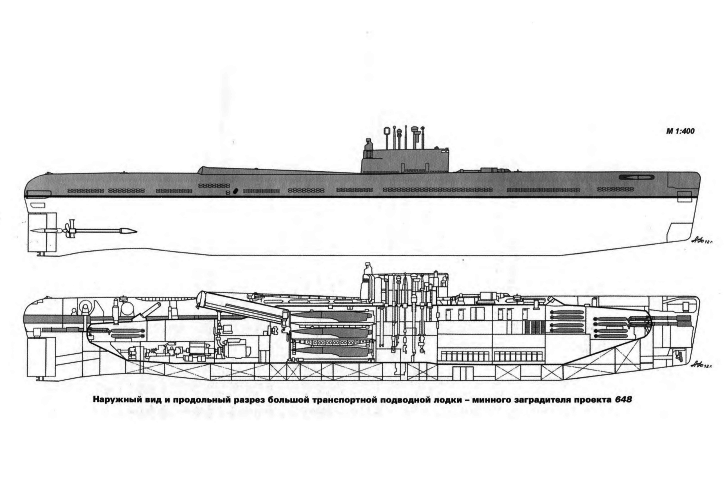
According to the new TTZ, the purpose of a large transport submarine - minelayer Ave 648 was the supply of submarines operating on the ocean and sea communications of the enemy, cruise missiles, torpedoes, fuel and lubricants and livelihoods; supply of seaplanes with aviation gasoline at sea; transportation of personnel and various cargoes to remote non-equipped coastal points, as well as setting up minefields on enemy communications. The tactical and technical requirements re-determined the composition of the transported cargo, ammunition of mines, torpedoes, and also established new values of shipbuilding and tactical-technical elements of the ship.
This required 17 to carry out design studies in order to determine the possibility of providing various functions, using the ship in the framework of an approved preliminary design, and 4 initiating studies to find the most appropriate design solutions for their implementation. Considering the ship’s so wide purpose, the methods for implementing these functions were developed in three versions. However, the designers immediately met with technical problems that they had to solve for the first time in submarine construction, including such as the creation of devices for transshipment in the open sea from one submarine to another of rockets, torpedoes and other goods, as well as devices and systems storage and transfer of diesel fuel to submarines, including in the process of underwater towing, transportation and transfer of flammable aviation fuel for hydroaviation, etc. It was clear that it was impossible to solve these problems only on paper; relevant full-scale experiments were required. Therefore, the bureau presented a list of basic works that included the manufacture of special stands and additional equipment for experienced ships for full-scale mining at sea.
Approving the proposals of the bureau, the Navy command in November 1958 signed a decision to carry out the necessary work and to allocate for the experiments two submarines Ave 611 and 613, as well as one destroyer Ave 30-bis. Considering the significance and volume of the forthcoming experimental work, a special chief designer was appointed for this purpose at the Central Design Bureau. He became MP Rempel In the process of developing a technical pr. 648, the corresponding working drawings were created and transferred to Severodvinsk plant No. 402 under her leadership. At the beginning of 1960, both the submarines and the destroyer were re-equipped, and soon full-scale experiments began in the sea. At the same time, the plant manufactured and designed for a submarine Ave 632, and a mine-dropping device adjusted for the 648 project.
The technical project 648 was submitted to Moscow as early as March of 1959 of the year and 24 of August of the same year was approved by a joint decision of the Navy and MOP. Moreover, the deadline for the release of working drawings was set at 1960 year, and the government decree, by which the ship's main TTEs were approved, determined the terms of its construction, as well as the supplying companies and the terms of delivery of all the necessary component equipment.
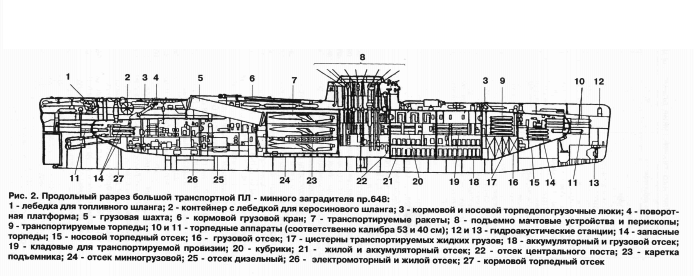
At the beginning of 1961, a plaza was equipped at the plant in Severodvinsk and production of hull sections of this submarine began. But the construction went hard. In addition, the construction of a single and very complex ship was economically unprofitable for the builder. It was much more profitable to build large-scale orders, and therefore the plant manager in every way sought to transfer the construction of this transport to another enterprise, or to close the project altogether.
Proponents of this position were found at the very top of the production and naval leadership, especially since the fleet had already initiated the development of a similar submarine, but now equipped with a nuclear power plant. By the end of 1960, only one topic was fully completed from the entire list of development work - a device for transferring diesel fuel from one submarine to another was developed and tested, including during their joint diving and underwater towing, and its completion was achieved solely due to assertiveness, high professional qualities of the leader of this topic B.N. Maisel. That is why 21 of June 1961 of the year was terminated by the Decree of the Central Committee of the CPSU and the USSR Council of Ministers on the 648 Ave.
It should be noted here that, as in the case of the 632 Pr submarine, the TsKB-16 leadership, realizing the limited capacity of diesel submarines, to solve transportation problems in remote areas, in coordination with the GCS and Navy, in the first half of 1959, organized the implementation of The new pre-sketch 648M project, which provided for the replacement with minimal rework of three (of the four planned for 648 ave.) groups of powerful expensive silver-zinc rechargeable batteries and two diesel engines for two small-sized nuclear power units of the type 0-153, according to 6000. with. each Their placement made it possible, while maintaining the displacement and submarine size, to obtain a qualitatively different ship — with underwater autonomy not 600, but 1900 hours, with increased long underwater speed and cruising range underwater up to about 20 000 miles.
The materials of these studies were submitted to the GCS and the Guk of the Navy, but did not receive further development. Navy specialists have already worked on the TTZ project with a more advanced atomic transport submarine - the minzag with powerful nuclear power plant and advanced radio-electronic weapons - the 664 avenue submarine. Another ship of a similar purpose, as time has shown, was seen by the SSN Ave 717.
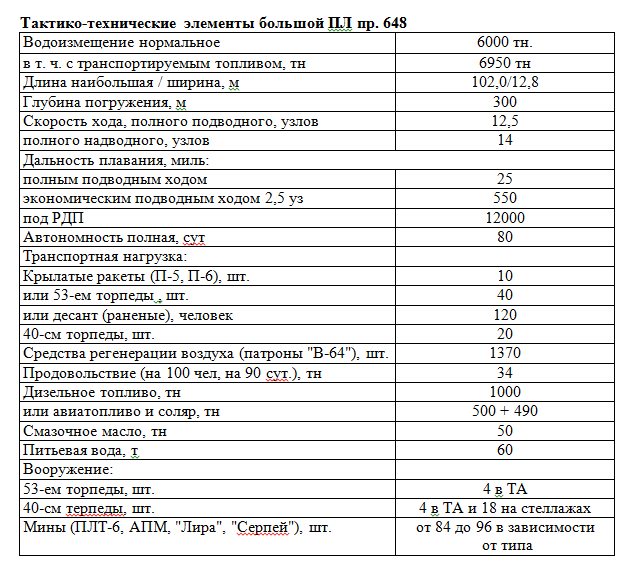
Sources:
Gusev A. Submarines for special purposes. SPb .: “Galeya Print”, 2002. C. 77-82
Shirokorad A.B. Soviet submarines of post-war construction M .: Arsenal Press, 1997. C. 118-121.
Zharkov V. Tyurin B. Underwater minzagi. // Sea collection. 1995. No.6. C. 65-69.
Shmakov R., Zharkov V. Transport underwater leviathans. // Military parade. 1998. No.29. C.43-47.
Ilyin V., Kolesnikov A. Experienced submarines and special purpose boats. // Technique and weapons. 2000. No.5-6. C. 87-88.
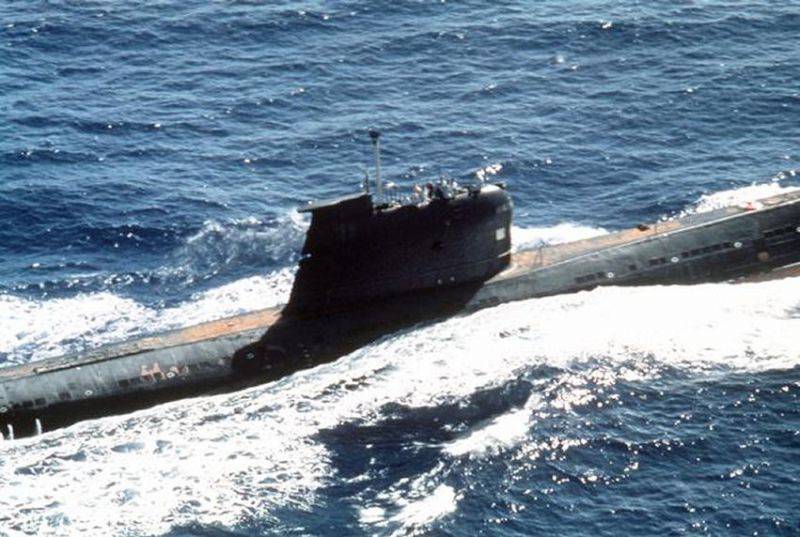
Information